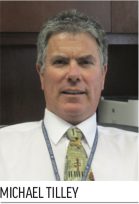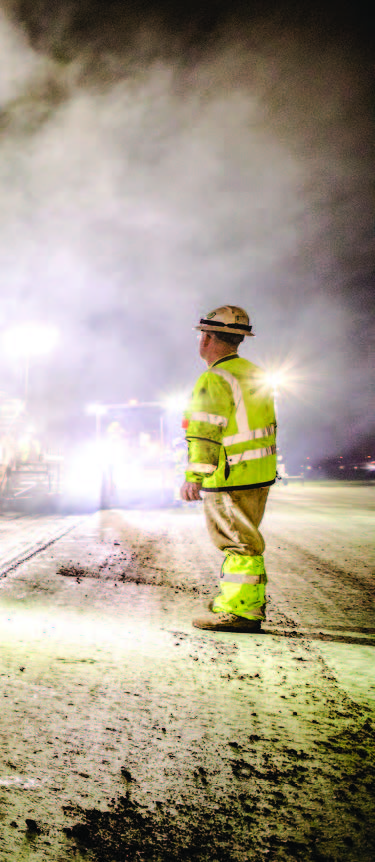As the busiest single-runway airport in North America, San Diego International (SAN) must plan and execute any airfield work with precision and efficiency. The recent full-length rehabilitation of its 9,401-foot runway was an especially critical project.
As the busiest single-runway airport in North America, San Diego International (SAN) must plan and execute any airfield work with precision and efficiency. The recent full-length rehabilitation of its 9,401-foot runway was an especially critical project.
“The challenge is ensuring that the runway operates each and every day,” says Michael Tilley, senior program manager of the San Diego County Regional Airport Authority. Last year, SAN served more than 24 million passengers and logged more than 225,000 flight operations.
In August 2018, the airport completed a $13.3 million rehabilitation of Runway 9-27 two months ahead of schedule. The nine-month project called for the milling and overlay of 3 inches of new asphalt on the entire 200-foot-wide runway. Crews also upgraded more than 600 airfield lights to LEDs with new transformers.
|
facts&figures Project: Runway Rehabilitation Location: San Diego Int’l Airport Managed by: San Diego County Regional Airport Authority Runway: 9-27 Size: 9,401 ft. long, 200 ft. wide Cost: $13.3 million Project Scope: Full-length mill & overlay; associated lighting upgrades Program Manager: AECOM Engineer of Record: Atkins, a member of the SNC-Lavalin Group Prime Contractor: Granite Construction Electrician: Ensley Electric Airfield Lighting: ADB SAFEGATE Quality Control Testing: Kleinfelder Inc. Timeline: 9 months Completed: Aug. 2018 Lighting Components: Converting 600 centerline, edge & touchdown zone lights from incandescent bulbs to LEDs Key Benefits: Maintaining pavement; increasing visibility for pilots; reducing energy consumption & maintenance requirements |
Every three to five years, the Airport Authority completes a pavement maintenance management study to chronicle the condition of all airfield pavement and guide plans to keep it in optimum condition. The 2015 study indicated that the runway was in “essentially fair condition,” but rehabilitation was necessary; and the project began in mid-November 2017.
Overnight Strategy
Because SAN’s sole runway had to be operational every day, phasing was paramount to the project’s success. As lead designer for the project, Atkins worked with the airport authority, airlines, airport operations and FAA to formulate a phasing plan that included a hard closure of the runway between 12 a.m. and 5 a.m. throughout the project.
But five hours of runway closure doesn’t provide five hours of paving time. Crews must first mobilize their equipment, set up lights and prepare the surface. “We were able to actually perform work for about three hours because of all the cleanup and logistics that had to take place—that was definitely difficult,” says Lance Jardine, project engineer at Granite Construction. “The logistical planning that had to be put into how we were going to accomplish it was the biggest challenge I’ve faced in my professional career.”
To make the most of the abbreviated worktime and achieve the needed pace, Granite developed a unique paving method that increased productivity tremendously, notes Tilley. The company even custom built a paver to expedite the process. On average, crews placed about 850 tons of asphalt each shift.
Planners divided the runway into 40 sections to maximize production and prevent biting off more than crews could chew during each five-hour closure. “It was really trying to find the sweet spot of how much can we produce in a night,” explains Jardine.
Each of the 40 sections was about 2,200 feet long and 20½ feet wide. A trio of 8-foot milling machines worked in tandem to grind out three passes of the 20½-foot width. After the old asphalt was removed, sweepers cleaned the milled surface to promote adhesion between the tack surface and new asphalt.
Belly dump trucks delivered asphalt in windrows, and then a material transfer vehicle scooped it up and placed it into the paver in a continuous motion. This increased the peak speed over conventional paving, explains Jardine.
A paver custom-built by Granite’s mechanics to be wide enough to cover the 20½-foot pass also expedited the process. After steamrollers compacted the new pavement, workers replaced the runway striping, cleaned the worksite and exited the field by 5 a.m.
“It was quite an operation each night,” Tilley remarks.
 The 40 sections were prioritized based on the other work that was also needed. “Depending on how much striping was in that subphase or how many lights are in that certain pull, that controlled how we performed that pass,” Jardine explains. “That was a big part of logistical planning.”
The 40 sections were prioritized based on the other work that was also needed. “Depending on how much striping was in that subphase or how many lights are in that certain pull, that controlled how we performed that pass,” Jardine explains. “That was a big part of logistical planning.”
Additionally, a large part of the runway was paved west to east, rather than east to west because of the amount of striping that needed to be complete by the 5 a.m. opening. “Things like that are what made the logistical planning of the subphases difficult and important,” Jardine notes.
With 100 to 200 workers on the runway each night, it was a little like “controlled chaos,” he quips. Once the clock struck midnight and crews received clearance from airport operations, workers moved quickly and efficiently to set up, perform the scheduled work, clean up and clear the field by 5 a.m. Making sure there were no materials left behind that could cause foreign object damage to aircraft was a priority every night.
Trucks, material delivery, equipment and workers had to be carefully choreographed. Often, there were 30 to 40 trucks entering and exiting the airfield, with workers dedicated to escorting vehicles in and out. Two staging/storage areas, one landside and one airside, allowed the contractor to keep heavy equipment nearby for easy access each night.
Because work was performed overnight/early in the morning, lighting the jobsite efficiently and effectively was a challenge. To do so, every person on the shift would tow a light tower and set it up in a preassigned area to illuminate the designated 2,200-foot stretch of runway. “Every tiny bit of the production had to be well thought out and well executed,” Jardine emphasizes.
Core samples were taken nightly to ensure proper asphalt mix and compaction of each lane. The quick response time of the quality control and assurance groups was key, Jardine notes. Core samples and in-place densities were turned around within two hours so the team could be certain the pavement that had just been placed met project specifications. “That was a huge helping point to see those results within a matter of an hour or two,” he says.
After a 28-day curing period, crews used a sawcut groover to make shallow, transverse lines to improve aircraft traction on the runway. Additionally, new pavement markings were installed on the runway and some taxiways to improve delineation.
In total, Granite milled and repaved about 2 million square feet and laid 35,000 tons of new asphalt.
Lighting Conversion
 In addition to paving, crews upgraded the touchdown zone, centerline and edge lights from incandescent fixtures to LED. Prior to this project, SAN’s last airfield lighting upgrade was in 2006, when incandescent centerline lights were installed. Since then, technology has evolved and the airport opted to install light emitting diodes (LEDs) to provide higher visibility for pilots. Because there cannot be a mixture of incandescent and LED lights on an airfield, all 132 edge lights had to be replaced in a single night. In addition to careful planning and timing, the contractor had multiple crews performing the operation to complete the work, Tilley explains.
In addition to paving, crews upgraded the touchdown zone, centerline and edge lights from incandescent fixtures to LED. Prior to this project, SAN’s last airfield lighting upgrade was in 2006, when incandescent centerline lights were installed. Since then, technology has evolved and the airport opted to install light emitting diodes (LEDs) to provide higher visibility for pilots. Because there cannot be a mixture of incandescent and LED lights on an airfield, all 132 edge lights had to be replaced in a single night. In addition to careful planning and timing, the contractor had multiple crews performing the operation to complete the work, Tilley explains.
Prior to asphalt milling, electricians cored out the pavement lights and lowered them below the 3-inch threshold of asphalt that would be removed and replaced to protect the lights from getting hit during milling. Once the prep and paving crews were finished, electricians located the lights via survey, cored them and raised them back up to elevation and replaced the fixtures with LEDs.
Centerline and touchdown zone lights were turned off throughout the duration of the project, so only edge lights had to be back on every morning. In total, crews upgraded more than 600 lights to LED fixtures with new transformers.

Precision Planning
The project proved to be a perfect example of how important advanced planning with all stakeholders is, Tilley advises. “We had numerous meetings with everyone involved so they knew what to expect,” he says. “What we tried to do was eliminate any surprises out in the field.”
Because of the zero margin for error, the team held detailed contingency planning meetings. “We talked about everything that could go wrong and what we could do to make sure that we could get the runway open on time each morning,” says Lori Steiner, senior project manager with Atkins.
 For example, if a milling machine broke down, there had to be equipment to move it off site, plus a backup milling machine ready to go. Such contingencies were especially critical for the paving portion of the work. “If a milling machine broke down and they couldn’t mill, as long as they repaved that section, it’s not a big deal,” she explains. “But if the pavers broke down and couldn’t repave, it would have been a big problem.”
For example, if a milling machine broke down, there had to be equipment to move it off site, plus a backup milling machine ready to go. Such contingencies were especially critical for the paving portion of the work. “If a milling machine broke down and they couldn’t mill, as long as they repaved that section, it’s not a big deal,” she explains. “But if the pavers broke down and couldn’t repave, it would have been a big problem.”
“Anything and everything that could go wrong we had to bring to light and discuss what we would do if it would happen,” Jardine adds. Often, there were three or even four levels of contingency plans, depending on how critical the project element was. “It was a partnering between the airport and Granite to come together and put contingencies in
place,” he says.
Steep fines were established to discourage any delays to the workflow. If the runway was not able to open at 5 a.m., the contractor would have been penalized with liquidated damages at the rate of $1,000 per minute for the first 15 minutes and $15,000 per minute for any minutes thereafter. No fine had to be levied.

Local Factors
The soft nature of Southern California’s aggregate required project planners to make special allowances for the material that would be used in the asphalt mix. Fortunately, the team was able to apply a lesson the airport learned from a 75-foot-wide keel section rehab in 2006. During that project, engineers discovered that when soft local aggregate goes through the plant, it creates dust that breaks up the bitumen binder and impedes full adherence. By washing the aggregate first, the team was able to achieve a tighter mix design, which ultimately led to a more reliable asphalt product.
Project planners also had to take into consideration the California Least Tern, an endangered bird that builds its nests from April through September on 20 acres at the east end of SAN’s runway. During that time, crews reversed their usual workflow and proceeded west to east to avoid disturbing the nesting sites.

Another important aspect to the project was informing the public about what was happening at SAN. The airport communications team used traditional and social media channels to inform and update travelers about the runway rehabilitation. “The main goal is to be sure that it’s a seamless experience from the passenger standpoint,” says Jonathan Heller, SAN senior communications specialist.
While the runway rehab was less apparent to passengers than a terminal or curbside project, the airport took care to consider its impact on surrounding communities. Due to the area’s topography, neighboring houses and businesses are at a higher elevation than the airport. “So there’s the issue of lighting and noise at night,” Heller explains. “We wanted to be sure that the community was aware so they wouldn’t be surprised.”
Noise did not prove to be an issue during this project, and special attention was paid to the position of work lights. “We look at the lighting layout and how it’s going to be directed so no lights are going up into the public areas,” Tilley says. “We’re sensitive to the needs of the people who live around the airport.”
Previous incandescent lighting:

New LED lighting:




